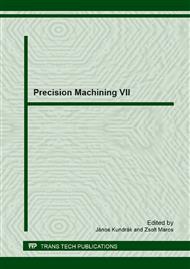[1]
BlueScope Steel, 2003. Tolerance Handbook, BlueScope Steel Limited.
Google Scholar
[2]
Krulikowski, A., 1998. Fundamentals of Geometric dimensioning and Tolerancing, Thomson Learning, Inc. ISBN 0-8273-7995-1.
Google Scholar
[3]
Aijun, T., Zhanqiang, L. 2007. Deformations of thin-walled plate due to static end milling force. Journal of materials processing technology. [Online] 15. December 2007. [Date: 17. 9. 2010. ] www. elsevier. com/locate/jmatprotec.
DOI: 10.1016/j.jmatprotec.2007.12.089
Google Scholar
[4]
Budak, E., Altintas, Y. 1995. Modeling and avoidance of static form errors in peripheral milling of plates. [Online] 4. 4 1995. [Date: 2. 9. 2010. ] ww. scincedirect. com.
DOI: 10.1016/0890-6955(94)p2628-s
Google Scholar
[5]
Budak, E., 2006. Analytical models for high performance milling. Part I. Cutting forces, structural deformations and tolerance integrity. Int. J. Mach. Tools. Manuf. 46, p.1478–1488.
DOI: 10.1016/j.ijmachtools.2005.09.009
Google Scholar
[6]
Ratchev, S., Liu, S., Becker, A.A., 2005. Error compensation strategy in milling flexible thin-wall parts, J. Mater. Process. Technol. 162–163, p.673–681.
DOI: 10.1016/j.jmatprotec.2005.02.192
Google Scholar
[7]
Ning, H., Zhigang, W., Chengyu, J., et al., 2003. Finite element method analysis and control stratagem for machining deformation of thin-walled components. J. Mater. Process. Technol. 139, p.332–336.
DOI: 10.1016/s0924-0136(03)00550-8
Google Scholar
[8]
Liu, X. W., Cheng,K., Webb, D. 2002. Prediction and simulation on the machining Dynamics and instability in peripheral milling, American Society for Precision Engineering. [Online] 2002. http: /www. aspe. net/publications/Annual_2002/PDF/POSTERS/4proc/ 2mach/865. PDF.
Google Scholar
[9]
Seguy, S., Dessein, G., l Arnaud, L. 2009. On the stability of high-speed milling with spindle speed variation, The International Journal of Advanced Manufacturing Technology, [Online] 2009. [Date: 15. 12 2009. ] http: /www. springerlink. com/content/nv7413 71272x8058/fulltext. pdf. ISSN 0268-3768 (Print) 1433-3015 (Online).
DOI: 10.1007/s00170-009-2336-9
Google Scholar


